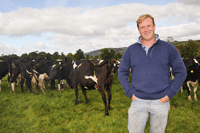Underpasses enable Irish milk producer to double herd size

Investing €130,000 in three road underpasses will enable an Irish milk producer to more than double his herd size.
Shane Maxwell had planned to create a new milking platform on a former tillage farm but, with the land fragmented by roads, his available milking platform restricted the stocking rate to 200 cows.
However, when he started costing underpasses, he realised he could incorporate two additional blocks of land totalling 49ha. “Three underpasses have cost me €130,000 but they will allow me to increase cows numbers to 500 instead of 200,” he says.
Mr Maxwell had been milking 440 cows on Lismore Farm, County Waterford, when he decided to create a new unit on the family’s tillage farm at nearby Moorehill.
Building work on the greenfield site began on 19 January 2010 and by 20 April cows were being milked in the new 50-point rotary parlour. In total, he is now milking 560 cows through two parlours.
Mr Maxwell has taken a gamble on his milk production volume because his total quota holding for both farms is 1.8m litres.
“I have taken a calculated risk. The view I have taken is that there are not enough cows in Ireland for the country to make quota. My figures tell me that we are 6% under, but I keep assessing my risk,” he says.
He is one of many farmers in southern Ireland who are expanding ahead of the removal of milk quotas in 2015.
With a quality herd ranked as eleventh in Ireland’s Economic Breeding Index (EBI), Mr Maxwell reasons that if he does have to pay a super levy fine he could close down one of his units in the short term and sell in-calf heifers and cows to generate cashflow. The only drawback he sees in this is that he would have to defer his expansion plans.
Mr Maxwell’s herd is mainly New Zealand Friesian-type cows, many which are crossed with a Jersey. Recently, to improve fertility and to further reduce a significant cell count problem, he opted for a three-way cross with Norwegian Reds.
“When you have a herd with good health and fertility, it’s a good point to move forward from. I can use genetics to buy milk production at a later stage if I want to,” he says. This year his empty rate after 12 weeks was 12%, and his overall empty rate was 8%.
Five years ago he had an average cell count reading of 600,000 cells/ml and, after ruling out problems with the plant, he adopted a policy of culling cows with high cell counts. His average cell count reading is now 170,000 cells/ml, but he says this is still too high. “I have been focusing on breeding to reduce it further,” he says.
He has selected 120 of his cows with the lowest cell counts to milk at Moorehill. The whole farm has been reseeded and a focus put on adding potassium to poor growing areas.
Improving access to the fields has resulted in 3.5km metres of six-metre wide tracks being created at a cost of €16 a linear metre. The furthest the cows have to walk to the parlour is 1.7km.
The only regret he has with the new system is that he didn’t pay more attention to his heifer rearing last winter. He out-wintered 230 heifers on kale and fodder beet supplement with big bale silage and oats. At bulling, the heifers were 30 kg underweight. “The weather was awful and I took my eye off the ball,” Mr Maxwell admits. “This year we are weighing and really focusing on managing the calves.”
UK Grassland Genetics manager for genus, Gareth Davies, who recently visited grassland farmers in Ireland with a group of UK dairy producers, describes Moorehill Farm as a perfect example of what can be achieved by correctly planning infrastructure ahead of expansion. “Good quality tracks in the correct locations with multiple entrances to each paddock, and well-positioned water troughs in each paddock will enable Mr Maxwell to maximise his grazing platform for years to come,” says Mr Davies.
